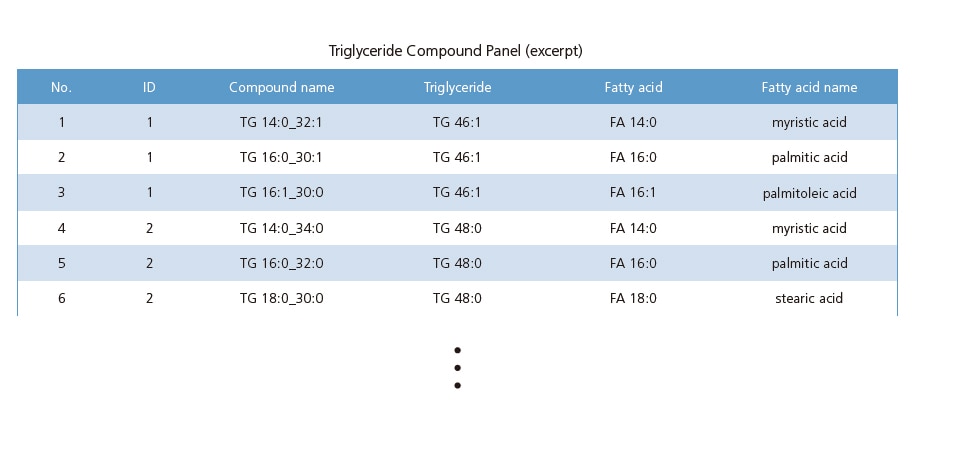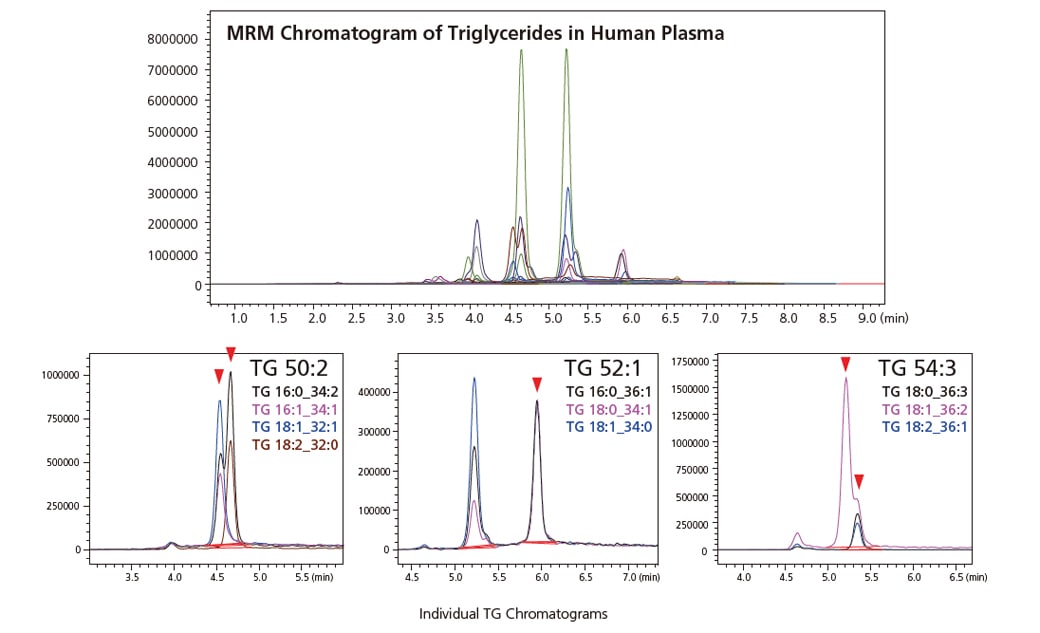LC/MS/MS MRM Library for Triglycerides
For LabSolutions™ LCMS

This MRM library targets fatty acids with carbon chain lengths of C14 to C22 and 0 to 6 unsaturation sites to profile the triglycerides (TG) in plasma. The library provides 195 MRM transitions, which enable 47 different triglycerides to be monitored. The MRMs were evaluated in human plasma in order to provide researchers a tool for qualitative profiling of fatty acid composition.
Example triglycerides with different fatty acid chains, corresponding to various MRM transitions in the library, are shown below. Fatty acid composition estimation is made possible by monitoring product ions from fatty acid neutral loss.

The MRM chromatogram below shows simultaneous analysis of 47 triglycerides in human plasma using Shimadzu’s LCMS-8060NX triple quadrupole mass spectrometer. MRM chromatograms corresponding to three typical triglycerides of unknown fatty acid composition are also shown. In the MRM chromatogram of TG 50:2, a doublet peak corresponding to TG 16:0_34:2 and three other peaks corresponding to TG 16:1_34:1, TG 18:1_32:1 and TG 18:2_32:0 can be observed. Assessment of this cumulative qualitative information shows that the TG 50:2 detected contains both TG 16:0 _16:1_18:1 and TG 16:0 _16:0 _18:2, demonstrating the utility of this qualitative MRM library.

Remarks and Precautions
LabSolutions LCMS Ver. 5.109 or later and LabSolutions Insight™ Ver. 3.8SP1 or later are required.
LabSolutions and LabSolutions Insight are trademarks of Shimadzu Corporation or its affiliated companies in Japan and/or other countries.
News / Events
-
Shimadzu has released the LCMS-8065XE
The new LCMS-8065XE is a triple-quadrupole mass spectrometer with EVOLVED, EFFICIENT, and EXACT capabilities. These exceptional capabilities ensure high reliability and enhanced productivity, empowering the laboratory for the future.
-
Latest issue of Shimadzu Journal, featuring Environmental Analysis, has come out.
This issue showcases advanced technologies and research tackling the global challenges posed by PFAS. As part of Shimadzu’s ongoing commitment to sustainability and problem solving, we strive to reduce environmental impacts and build a better future.
-
New High Resolution Accurate Mass Library for Forensic Toxicology
Perform forensic toxicology screening for drugs of abuse, psychotropic drugs, pharmaceuticals, pesticides, and natural toxins using this high-resolution accurate mass database.
-
Shimadzu has released the Shim-vial™ H glass, S glass.
Shimadzu provides high-quality vials that thoroughly eliminate these risks by visually inspecting each vial, allowing them to be used with confidence.
-
INTERNATIONAL MASS SPECTROMETRY CONFERENCE 2024
Visit the Shimadzu booth at the International Mass Spectrometry Conference (IMSC) 2024.
-
Metabolomics 2024
Shimadzu Lunch Presentation at Metabolomics 2024
Date: June 20th, 2024 (Thursday)
Time: 12:25 – 1:25 p.m.



